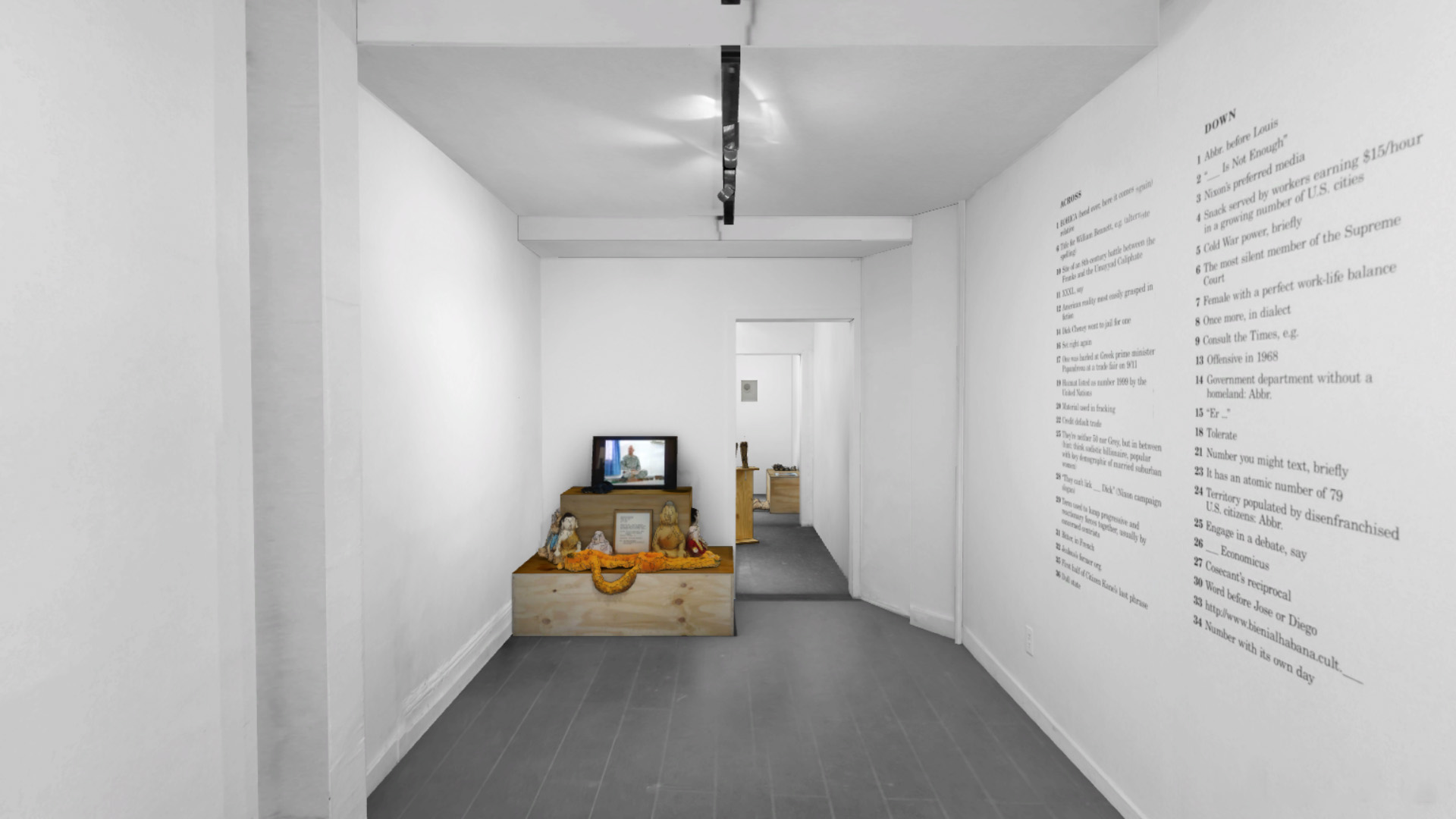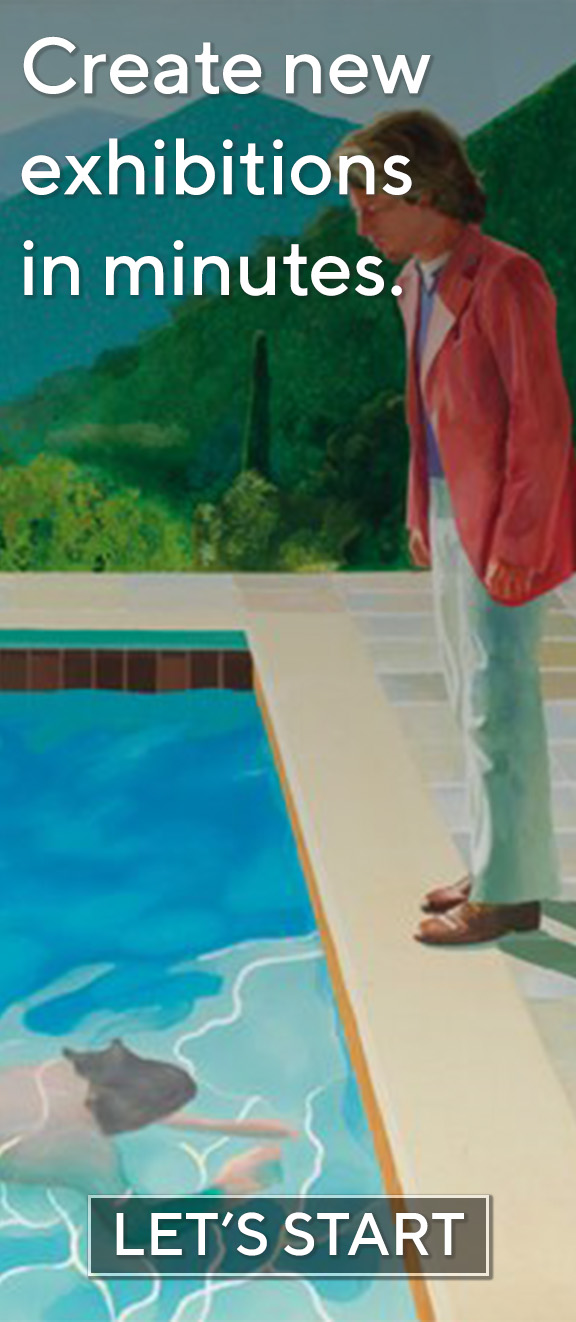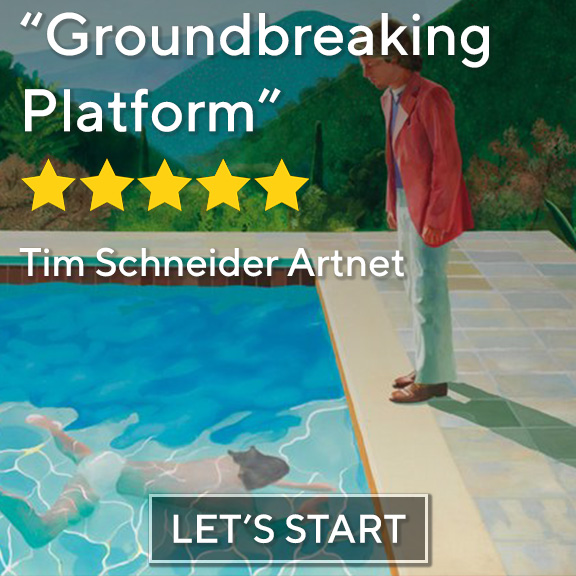

The black squares, usually used as fillers, are here converted in... more >> Kai Matsumiya welcomes Maryam Jafri’s debut solo exhibition, “War on Wellness.” The centerpiece is “Where We´re At,” a work in which the artist has fabricated an 8 ½ ft by 8 ½ ft functional crossword puzzle made of wood in collaboration with noted crossword puzzle constructor Ben Tausig, a regular contributor to the New York Times and other national newspapers.
The black squares, usually used as fillers, are here converted into bookshelves with books glued directly onto the wood. The sixteen books selected by Jafri span historical, contemporary, academic, pop, self-help, business and fiction genres. The books employed were inspired by a list of six books circulated by the New York Times shortly after the surprise result of last year’s presidential election. Jafri’s sixteen books were chosen for their relevance to the present political moment. These books include seminal works by Friedrich von Hayek (economist from the Austrian School of Economics, a precursor to the Chicago School), fiction by Margaret Atwood, Ayn Rand and Newt Gingrich, advice books by PT Barnum and Jon Kabat-Zinn, and Ibn Khaldun´s Muqaddimah, a 14th century book cited by many as the first work on supply side economics. The clues, focusing on inequality, gender and race politics, and recent US history, are written in black vinyl directly onto the wall nearby. A letter-size take-away of the crossword puzzle is available to visitors who wish to solve it.
Also in the front room is “American Buddhist.” This sculpture, made to resemble a meditation altar, reveals a video of Captain Dyer who leads troops through a meditation session on a US Army base in Iraq. The video is a public domain video sourced directly from the US Army. Around and below the flat panel monitor are various stuffed animals and cartoonish Buddhas made for children, garlands of fake orange flowers, and a framed text panel. An inverse of the scene in Stanley Kubrick´s Full Metal Jacket, in which American soldiers prepare for combat under the training of a sadistic taskmaster, and these new techniques deploy a more holistic approach. “American Buddhist” invites the viewer to experience Captain Dyer´s instructions to his combat subjects.
The back room instantiates Jafri´s “Wellness-Postindustrial Complex” series in its present state through works such as “Anxiety,” “Depression,” “Self-care,” “boy & boy continued,” “ANT (Automatic Negative Thought),” and “Schadenfreude.”In recent years, the term “wellness” has become a laden, yet specific, phrase that resembles a contemporary ideological movement spanning across the spheres of culture, industry, politics, class, race, gender, and even the military, that centers solely around an individual’s self-existence, than merely a word.
The sculptures and photo works in the Wellness-Post-Industrial Complex series present a rift between mind, body and self that is rough, mute and fragmented. These works, despite their personal and seemingly interior tone, deliberately incorporate mass-produced objects, such as silicone body parts sourced from online fetish stores in China and stock photos presented with watermarks intact, underlining how the search for interiority and personal narratives leads paradoxically, but logically enough, to the exterior world.
The exhibition, taken in its entirety, and as its title indicates, suggests that the present conditions of the “wellness” phenomenon may be a logical response to a government that is actively plotting to destroy its own citizens access to health care and the social safety net, so that people are forced to desperately seek out DIY, self-help solutions—a full-out war on the wellness of people´s minds, bodies and spirits, waged by the current regime in Washington. Workers, including members of the precariat and the creative class, are left with only their labor power as their sole means of support. The body is increasingly perceived as a site of anxiety that is politically and economically produced. Mass narcissism—an endless search for optimization and self-surveillance—becomes a universal norm. Post-industrial workers, especially artists, are perhaps particularly prone to the wellness movement. Their minds, that is to say their creativity, constitute their labor power, and Eastern self-care practices are marketed as offering access to mental optimization via the body.
Later this year, Maryam Jafri will have a solo exhibition at Institute of Contemporary Art, Los Angeles and participate in Front International, Cleveland Triennial for Contemporary Art. Recent notable solo exhibitions have been held at Van Abbemuseum, Institute of Modern Art Brisbane, P! (2016), Kunsthalle Basel, Betonsalon (2015), Gasworks (2014). Recent biennials and notable group exhibitions include Sao Paulo Biennial (2016), Belgian Pavilion, Venice (2015), Situations at Fotomuseum Wintherthur (2016), Fassbinder Jetzt at Martin Groupius Bau (2015), Video Container at Museum of Contemporary Art North Miami (2014) and One Hundred Tricks, One Hundred Wiles at Beirut Art Center (2014).










